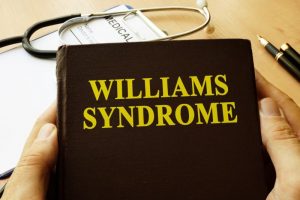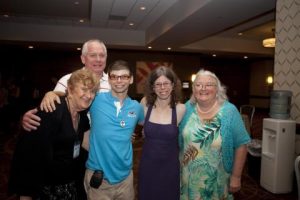
Williams Syndrome: When loving too much can be a disorder

Yet, beyond the make-believe mask of mischievous upturned noses, pointed chins and flashy smiles, some grim tales of woe and pain are brewing, and they are more than fictional.
For these individuals with distinctive elf-like facial features, the goodness of heart and the vulnerability of trust are symptoms of a genetic disorder – Williams Syndrome – that affects an estimated 1 in 7,500 to 10,000 people.
Origins date back to early mythology
Most people with Williams are as pure as the fairies we encounter in our library of myths and tales. Despite their intellectual challenges, they are chatty, witty and tremendously charming — they tend to hug everyone they meet.
Biologist Howard Lenhoff began to study the syndrome after his own daughter was diagnosed with the disorder.
“It seems logical to me, and to others, that the legends we hear about music-loving, kind-hearted fairies and elves might be the way people used to talk about Williams.”
The genetic roots were traced only in the mid-1990s. Before the advent of science and medicine, Williams Syndrome could have been the inspiration behind Grimm’s’ fairy tales, and supernatural interpretations saw the illness as being brought about via witchcraft and demonic possession rather than germs and genetic abnormalities.
People with Williams must have been perceived as out-of-the-world in mainstream society then; they still do, in some ways.
“I find myself not wanting to say ‘people with Williams Syndrome’ — I want to say ‘Williams people’. They do seem to be a people with an identity of their own… These are a different sort of people,” observed neurologist and author Oliver Sacks.
In medieval and Renaissance Europe, their musical inclinations along with their verbal dexterity and good humour, could have made these Williams people suitable for roles as court jesters or entertainers, especially when they are ever eager to please.
Historian Suzannah Lipscomb argues that many, if not all, the court “fools” of England’s early Tudor period were people with learning disabilities. And although these roles were exploitative, they were also a place of privilege that gave people with intellectual disabilities a more visible and prestigious place than they occupy in contemporary society.
Rare genetic disorder that can occur in people with no genetic history

Williams Syndrome, also called Williams-Beuron Syndrome or Elfin Facies Syndrome, is an autosomal dominant condition. In a small percentage of cases, people with Williams Syndrome inherit the chromosomal deletion from a parent with the condition. Researchers believe that a loss of several of these genes probably contributes to the characteristic features of this disorder.
More than one gene may contribute to social abnormalities in the disorder. A study published in October 2010 found that mice lacking a protein called PSD-95 had more social characteristics.
Presented with a choice between exploring a room with an empty cage in it or a room with a cage holding a mouse inside, the PSD-95 mutant mice choose the room with the playmate. In fact, they spend even more time with the new mouse than do controls.
The other end of the autism spectrum
In a recent shooting in a classroom in San Bernadino, California, nine-year-old Jonathan Martinez, who was affected with the syndrome, was one of three victims who died. Jonathan’s parents shared that his legacy would highlight the need for an increased awareness and understanding of the genetic disorder.
Children with Williams Syndrome display a range of cognitive symptoms such as a happy and highly social demeanour, developmental delay and strong language skills. They also have cardiovascular symptoms and dysmorphic facial features, such as a small nose with a flattened bridge, and a small chin.
Typically, they have difficulty with visual-spatial tasks like drawing and assembling puzzles, but may do well on tasks that involve spoken language, music, and learning by repetition.
These individuals often have problems with anxiety and phobias, and may suffer from attention deficit disorder (ADD). They tend to operate on the other end of the autism spectrum, as they love to talk and tell stories, whereas those with autism usually have language delay and little imagination.
However, some of these individuals are also diagnosed with autism. This suggests that they share an underlying mechanism and understanding one disorder could shed light on the other.
Those who choose to find beauty and joy in everyday life
The Williams Syndrome Association (WSA), which was set up in 1982 to provide support and resources for people with Williams syndrome, hopes to celebrate the joys and acknowledge the challenges associated with the illness, and offers a an online and offline platform for families and professionals to discuss and share insights.
Among the families that have received support from the WSA are Terry Monkaba and her child, Ben.
According to Terry, Ben is truly an optimist – a young man who simply chooses to find beauty and joy, not just in special occasions but in everyday activities as well. More importantly, he readily shares his feelings with everyone he meets.
In his early days, he was afraid of the dentist, but no matter how much he cried throughout the session, each visit ended with him wiping the tears from his eyes and exclaiming, “Thank you, Dental Officers. I know you took good care of me”.
“… despite the challenges, Ben has much to offer, and so often reminds me of what is important in this life and what we should truly cherish. Ben is quite simply… something special,” Terry shared.MIMS
Read more:
A closer look at 4 of the rarest heart diseases
5 rare medical conditions
Living with rare diseases
Sources:
http://time.com/4823574/mythology-williams-syndrome/
https://williams-syndrome.org/ThatSomethingSpecial
http://www.houstonmatters.org/segments/segment-e/2017/06/20/when-friendliness-becomes-a-disorder-inside-williams-syndrome-in-the-boy-who-loved-too-much
https://williams-syndrome.org/blog/special-awareness-campaign
http://www.medicinenet.com/williams_syndrome/index.htm
https://spectrumnews.org/wiki/williams-syndrome/
Video
Source:
https://today.mims.com/topic/williams-syndrome-when-loving-too-much-can-be-disorder?country=malaysia


Kami adalah firma pemberi pinjaman swasta, Kami menawarkan Pinjaman pada kadar faedah yang rendah kepada mana-mana individu Individu Tertarik. Kami adalah pembantu kewangan berdaftar yang berdaftar Kerajaan. untuk maklumat lanjut mengenai cara mendapatkan Pinjaman kami hubungi kami hari ini melalui e-mel: (mrhamdnloanoffer@gmail.com) ANDA BOLEH JUGA MENAMBAHKAN US ON WHATSAPP (+447783281085)
Thanks for your helpful article. One other problem is that mesothelioma cancer is generally the result of the inhalation of fibers from asbestos, which is a positivelly dangerous material. It truly is commonly seen among personnel in the structure industry with long contact with asbestos. It can also be caused by moving into asbestos protected buildings for some time of time, Genetics plays an important role, and some individuals are more vulnerable for the risk as compared to others.